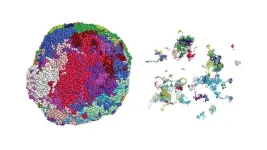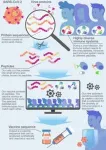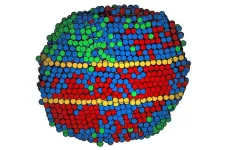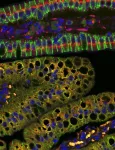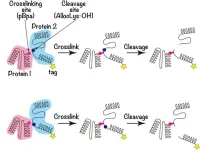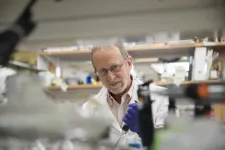(Press-News.org) The mammalian nose is a work of evolutionary art. Its millions of nerve cells, each tailored with just one of thousands of specific odor-chemical receptors encoded in the genome, can collectively distinguish a trillion distinct scents. Those sensations, in turn, inform many behaviors, from assessing food options to discerning friends from foes to sparking memories.
Today, in the journal Nature, a research team led by scientists at Columbia’s Zuckerman Institute describes a previously undetected mechanism in mice—starring the genetic molecule RNA—that could explain how each sensory cell, or neuron, in mammalian noses becomes tailored to detect a specific odor chemical.
For example, there are sensory neurons in our noses that bear receptors uniquely tuned to detect ethyl vanillin, the main odorant in vanilla, and other cells with receptors for limonene, lemon’s signature odorant.
“How sensory cells in the nose make their receptor choices has been one of the most vexing mysteries about olfaction,” said Stavros Lomvardas, Ph.D., a Herbert and Florence Irving Professor at Columbia’s Zuckerman Institute and corresponding author on the paper. “Now, the story behind our sense of smell, or olfaction, is becoming clearer, and also more dramatic.”
The sense-refining drama he is referring to unfolds entirely within the minuscule confines of each olfactory neuron’s nucleus, where the cell’s chromosomes and genes reside. There, in a Squid Games-style, winner-takes-all competition, a developing cell’s myriad olfactory receptor genes vie with each other in a process that winnow them down, in stages, first to handful of finalists and then to a single winner. The prevailing gene is the one that determines the cell’s odorant sensitivity. In their study, Dr. Lomvardas and his team uncover details of the final stage of this process when the winner emerges from the finalist genes.
“It’s basically a battle between a 1000 contenders,” said Ariel Pourmorady, the paper’s first author and an M.D.-Ph.D. candidate at the Zuckerman Institute in the Lomvardas lab.
The action is exceedingly complex and involves a dizzying cast of molecular characters. Playing roles that either dial up or down each gene’s ability to produce olfactory receptors are a variety of gene-regulating molecules. By gathering into various alliances within the genome, these molecular players help turn specific genes on or off.
Also in the fray is another set of molecular hubs that reshape portions of the genome in ways that favor specific receptor genes. When his team first observed these in the genome in 2014, Dr. Lomvardas dubbed them “Greek Islands” because they reminded him of islands in the Aegean Sea.
“It turns out that the genome has a certain spatial organization in the nucleus and changes in this structure are pivotal when it comes to which genes are expressed into proteins, like olfactory receptors,” said Pourmorady. “We are learning just how important this process is within maturing olfactory cells.”
In their new Nature paper, the researchers summon a trove of data from mouse studies pointing toward RNA as the linchpin molecule in the olfactory system’s gene-choosing mechanism. RNA is most known as the go-between molecule that translates the genetic code embodied in DNA into protein molecules with specific cellular jobs, like detecting odorants. Using sophisticated techniques for analyzing changes in genome structure as cells mature, however, the researchers say their evidence points to a pivotal second role for the RNA.
“It looks like the RNA the cell makes during gene expression also is altering the genome’s architecture in ways that bolster the expression of one olfactory receptor gene while also shutting down all the others,” Pourmorady said.
Big gaps in this genome-controlling story remain, but the researchers say the outline
is becoming more defined. It starts with maturing olfactory cells, which initially express many receptor genes at those genomic hubs where gene-regulating molecules and complexes, including Greek Islands, converge.
Then the RNA winnows the contending olfactory-receptor genes down to one. The particular hub in each cell where the molecular stars align to produce the highest amount of RNA wins the competition. At this hub, receptor-gene expression soars. But, like a slinky saboteur, RNA from that same hub may wind its way to all the other hubs. In those locations, the RNA causes shape changes in the genome that shut down gene expression. The result is a nose’s worth of mature olfactory neurons, each of which bears on its surface only one odorant receptor.
“We are reaching the edge of science fiction when it comes to the molecular and genomic details we now can observe inside a single cell’s nucleus,” said Dr. Lomvardas. “We need to keep going back in to figure out the rest of this olfaction puzzle.”
###
The paper, “RNA-mediated symmetry breaking enablessingular olfactory receptor choice,” was published today in Nature.
The full list of authors includes Ariel D. Pourmorady, Elizaveta V. Bashkirova, Andrea M. Chiariello, Houda Belagzhal, Albana Kodra, Rachel Duffié, Jerome Kahiapo, Kevin Monahan, Joan Pulupa, Ira Schieren, Alexa Osterhoudt, Job Dekker, Mario Nicodemi and Stavros Lomvardas.
The authors declare no competing interests.
END
A trillion scents, one nose
Smell’s sensory magic emerges from intricate developmental mechanism that tailors each of nose’s sensory cells, mice studies suggest
2023-12-20
ELSE PRESS RELEASES FROM THIS DATE:
Innovation in development of dermatologic drugs approved by the FDA
2023-12-20
About The Study: Compared with prior decades, the number of new dermatologic drug approvals by the Food and Drug Administration (FDA) increased between 2012 and 2022. Nearly half of these drugs were considered first in class or first in indication, and several were deemed clinically useful or to have high added therapeutic benefit by health technology assessment organizations in Germany, Canada, or France.
Authors: Ravi Gupta, M.D., M.S.H.P., of the Johns Hopkins University School of Medicine ...
New brain-like transistor mimics human intelligence
2023-12-20
Taking inspiration from the human brain, researchers have developed a new synaptic transistor capable of higher-level thinking.
Designed by researchers at Northwestern University, Boston College and the Massachusetts Institute of Technology (MIT), the device simultaneously processes and stores information just like the human brain. In new experiments, the researchers demonstrated that the transistor goes beyond simple machine-learning tasks to categorize data and is capable of performing associative learning.
Although previous studies have leveraged similar strategies to develop brain-like computing devices, those transistors cannot function outside cryogenic temperatures. The new ...
Home-delivered meals and nursing home placement among people with self-reported dementia
2023-12-20
About The Study: This pilot pragmatic clinical trial included 243 homebound older adults with self- or proxy-reported dementia found a lower although nonsignificant likelihood of nursing home placement among those receiving daily-delivered meals compared with those receiving drop-shipped frozen meals. While this study was not powered to detect meaningful, statistically significant differences in nursing home placement, its feasibility and initial results warrant exploration in an adequately powered trial.
Authors: Kali S. Thomas, Ph.D., of the Brown University School of Public Health in Providence, Rhode Island, is the corresponding author.
To access the embargoed ...
Integrating research and clinical care to uncover secrets of brain development
2023-12-20
The human brain continues to be built after we are born for far longer than previously recognized, suggests research by Shawn Sorrells, assistant professor of neuroscience in the Kenneth P. Dietrich School of Arts and Sciences. Sorrells’s research on postnatal brain development, published today inthe journal Nature, shines light on fundamental processes that contribute to the development of important brain functions, such as learning, memory and spatial navigation.
The new research suggests that a subset of inhibitory neurons within the entorhinal cortex, or EC -- an area of the brain essential for forming memories -- continue ...
Meet 'Coscientist,' your AI lab partner
2023-12-20
In less time than it will take you to read this article, an artificial intelligence-driven system was able to autonomously learn about certain Nobel Prize-winning chemical reactions and design a successful laboratory procedure to make them. The AI did all that in just a few minutes — and nailed it on the first try.
"This is the first time that a non-organic intelligence planned, designed and executed this complex reaction that was invented by humans," says Carnegie Mellon University chemist and ...
3D atomic details of next-generation alloys revealed for first time
2023-12-20
Alloys, which are materials such as steel that are made by combining two or more metallic elements, are among the underpinnings of contemporary life. They are essential for buildings, transportation, appliances and tools — including, very likely, the device you are using to read this story. In applying alloys, engineers have faced an age-old trade-off common in most materials: Alloys that are hard tend to be brittle and break under strain, while those that are flexible under strain tend to dent easily.
Possibilities for sidestepping that trade-off arose about 20 years ago, when researchers first developed medium- and high-entropy alloys, stable materials that combine ...
Catalyzing drug discovery with explainable deep learning
2023-12-20
Scientists have discovered one of the first new classes of antibiotics identified in the past 60 years, and the first discovered leveraging an AI-powered platform built around explainable deep learning.
Published in Nature today, the peer-reviewed paper, entitled “Discovery of a structural class of antibiotics with explainable deep learning,” was co-authored by a team of 21 researchers, led by Felix Wong, Ph.D., co-founder of Integrated Biosciences, and James J. Collins, Ph.D., Termeer Professor of Medical Engineering ...
Study unveils a role of mitochondria in dietary fat processing
2023-12-20
The maintenance of a balanced lipid homeostasis is critical for our health. While consumption of excessive amounts of fatty foods contributes to metabolic diseases such as obesity and atherosclerosis, fat is an indispensable component of our diet. Digested lipids supply the body with essential building blocks and facilitate the absorption of important vitamins. In a new study published in the journal Nature, a team of researchers led by Professor Manolis Pasparakis and their collaborators Professor Aleksandra Trifunovic and Professor Christian Frezza at the Excellence Cluster CECAD of the University of Cologne, and Professor Jörg Heeren ...
Protein secrets unveiled: Newl molecular insight of protein–protein interactions
2023-12-20
Researchers from Tokyo Medical and Dental University (TMDU) have developed a new technique allowing the binding interfaces on two interacting proteins to be characterized, and validated it by describing the homophilic interaction between LAMP2A molecules
Tokyo, Japan – Proteins are building blocks of our bodies, but they do not work solo. They form partners to facilitate in different biological processes that keep us going. However, analyzing how proteins interact at a molecular level can be challenging. Now, a research team from Japan reveals the secrets behind these “protein partnerships”.
In a study published recently in Protein Science, researchers ...
Alzheimer’s discovery reveals dire effect of toxic tau protein on brain cells
2023-12-20
University of Virginia Alzheimer’s researchers have discovered how harmful tau proteins damage the essential operating instructions for our brain cells, a finding which could lead to new treatments.
The toxic protein, the researchers found, warps the shape of the nuclei of nerve cells, or neurons. This alters the function of genes contained inside and reprograms the cells to make more tau.
While the protein has long been a prime suspect in Alzheimer’s and other neurodegenerative “tauopathies,” the new research from UVA’s ...
LAST 30 PRESS RELEASES:
Making lighter work of calculating fluid and heat flow
Normalizing blood sugar can halve heart attack risk
Lowering blood sugar cuts heart attack risk in people with prediabetes
Study links genetic variants to risk of blinding eye disease in premature infants
Non-opioid ‘pain sponge’ therapy halts cartilage degeneration and relieves chronic pain
AI can pick up cultural values by mimicking how kids learn
China’s ecological redlines offer fast track to 30 x 30 global conservation goal
Invisible indoor threats: emerging household contaminants and their growing risks to human health
Adding antibody treatment to chemo boosts outcomes for children with rare cancer
Germline pathogenic variants among women without a history of breast cancer
Tanning beds triple melanoma risk, potentially causing broad DNA damage
Unique bond identified as key to viral infection speed
Indoor tanning makes youthful skin much older on a genetic level
Mouse model sheds new light on the causes and potential solutions to human GI problems linked to muscular dystrophy
The Journal of Nuclear Medicine ahead-of-print tip sheet: December 12, 2025
Smarter tools for peering into the microscopic world
Applications open for funding to conduct research in the Kinsey Institute archives
Global measure underestimates the severity of food insecurity
Child survivors of critical illness are missing out on timely follow up care
Risk-based vs annual breast cancer screening / the WISDOM randomized clinical trial
University of Toronto launches Electric Vehicle Innovation Ontario to accelerate advanced EV technologies and build Canada’s innovation advantage
Early relapse predicts poor outcomes in aggressive blood cancer
American College of Lifestyle Medicine applauds two CMS models aligned with lifestyle medicine practice and reimbursement
Clinical trial finds cannabis use not a barrier to quitting nicotine vaping
Supplemental nutrition assistance program policies and food insecurity
Switching immune cells to “night mode” could limit damage after a heart attack, study suggests
URI-based Global RIghts Project report spotlights continued troubling trends in worldwide inhumane treatment
Neutrophils are less aggressive at night, explaining why nighttime heart attacks cause less damage than daytime events
Menopausal hormone therapy may not pose breast cancer risk for women with BRCA mutations
Mobile health tool may improve quality of life for adolescent and young adult breast cancer survivors
[Press-News.org] A trillion scents, one noseSmell’s sensory magic emerges from intricate developmental mechanism that tailors each of nose’s sensory cells, mice studies suggest
